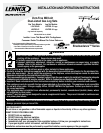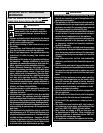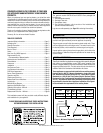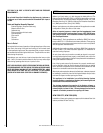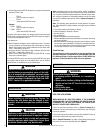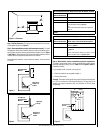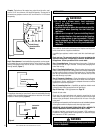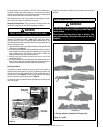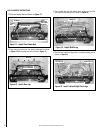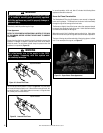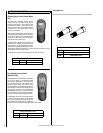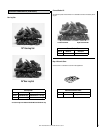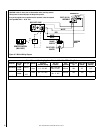
NOTE: DIAGRAMS AND ILLUSTRATIONS ARE NOT TO SCALE.
6
Note: Illustrations shown in this manual reflect “typical” installations
with nominal dimensions and are for reference only. Actual installations
may vary due to individual design preferences. However, always main-
tain minimum clearances to combustible materials and do not violate
any specific installation requirements. Refer to Figures 2 through 8 for
clearances.
Note: The following steps represent the normal sequence of installa-
tion. Each installation is unique, however, and might require a different
sequence.
• Turn off gas supply to the fireplace or firebox.
• Position appliance in fireplace or firebox.
• Connect gas line.
• Secure appliance.
• Operate the appliance and check operation.
• Maintain adequate clearances for accessibility for purposes of servicing
and proper operation.
• Minimum clearances include any projections such as shelves, window
sills, mantels, spacers/standoffs or surfaces to combustible construc-
tion etc. above the appliance. Paint or lacquer used to finish the mantel
must be heat resistant in order to avoid discoloration.
Check Gas Type
This appliance can only be connected to the gas type specified on the
appliance rating plate. This appliance can not be modified in the field
for a different gas type. If the gas supply differs, DO NOT INSTALL the
appliance. Contact your dealer to obtain the correct appliance.
VENT FREE APPLICATIONS
WHEN INSTALLED IN A VENT-FREE FIREBOX, IF THE CLEARANCES
SHOWN ON PAGES 7 & 8 OF THIS MANUAL ARE GREATER THAN THE
CLEARANCES FOR THE VENT-FREE FIREBOX, THE LESSER CLEAR-
ANCES OF THE VENT-FREE FIREBOX APPLY.
Ensure the minimum clearances shown in
Figures 2 through 8 are
maintained. Left and right clearances are determined when facing the
front of the appliance.
Follow these instructions carefully to ensure safe installation. Failure to
follow these requirements may create a fire hazard.
Step 1. Sidewall Clearances: The sides of the fireplace opening must
be at least 16" from any combustible side wall (Figure 2).
4. Compare the maximum BTU/Hr the space can support with the actual
amount of BTU/Hr used.
_________ BTU/Hr
(max. the space can support)
_________ BTU/Hr
(actual amount of BTU/Hr used)
Example:
61,440 BTU/Hr
(max. the space can support)
71,000 BTU/Hr
(actual amount of BTU/Hr used)
The space in the above example is a confined space because the actual
BTU/Hr used is more than the maximum BTU/Hr the space can support.
You must provide additional fresh air.
Your options are:
a. Rework equations adding the space of adjoining room(s). If the extra
volume provides an unconfined space, then remove door or add ven-
tilation grills between rooms. Refer to National Fuel Gas Code, ANSI
Z223.1 - latest edition, Section 5.3.
b. Vent room directly to the outdoors. Refer to National Fuel Gas Code,
ANSI Z223.1 - latest edition, Section 5.3.
c. Install a lower BTU/Hr appliance, such as a 24,000 BTU/Hr, to make
the area an unconfined space.
If the actual BTU/Hr used is less than the maximum BTU/Hr the space
can support, then the space is an unconfined space. You will need no
additional fresh air ventilation for an unconfined space.
WARNING
If the area in which the heater may be operated is smaller
than that defined as an unconfined space or if the build-
ing is of unusually tight construction, you must provide
adequate combustion and ventilation air by one of the
methods described in the National Fuel Gas Code, ANSI
Z223.1, Section 5.3 or applicable local codes.
PREINSTALLATION
WARNING
Before installing in a solid fuel burning fireplace, the
chimney flue and firebox must be cleaned of soot,
creosote, ashes and loose paint by a qualified chimney
cleaner.
CAUTION
Appliances create warm air currents. These currents
move heat to wall surfaces next to appliance. Install-
ing appliance next to vinyl or cloth wall coverings or
operating appliance where impurities in the air (such
as tobacco smoke) exists, may discolor walls.
WARNING
Do not install this gas appliance:
• In sleeping quarters, bathrooms, or a recreational
vehicle.
• Where curtains, furniture, clothing or other flammable
objects are less than 42" from the front of the gas
appliance.
• In high traffic areas.
• In windy or drafty areas.
CLEARANCES



